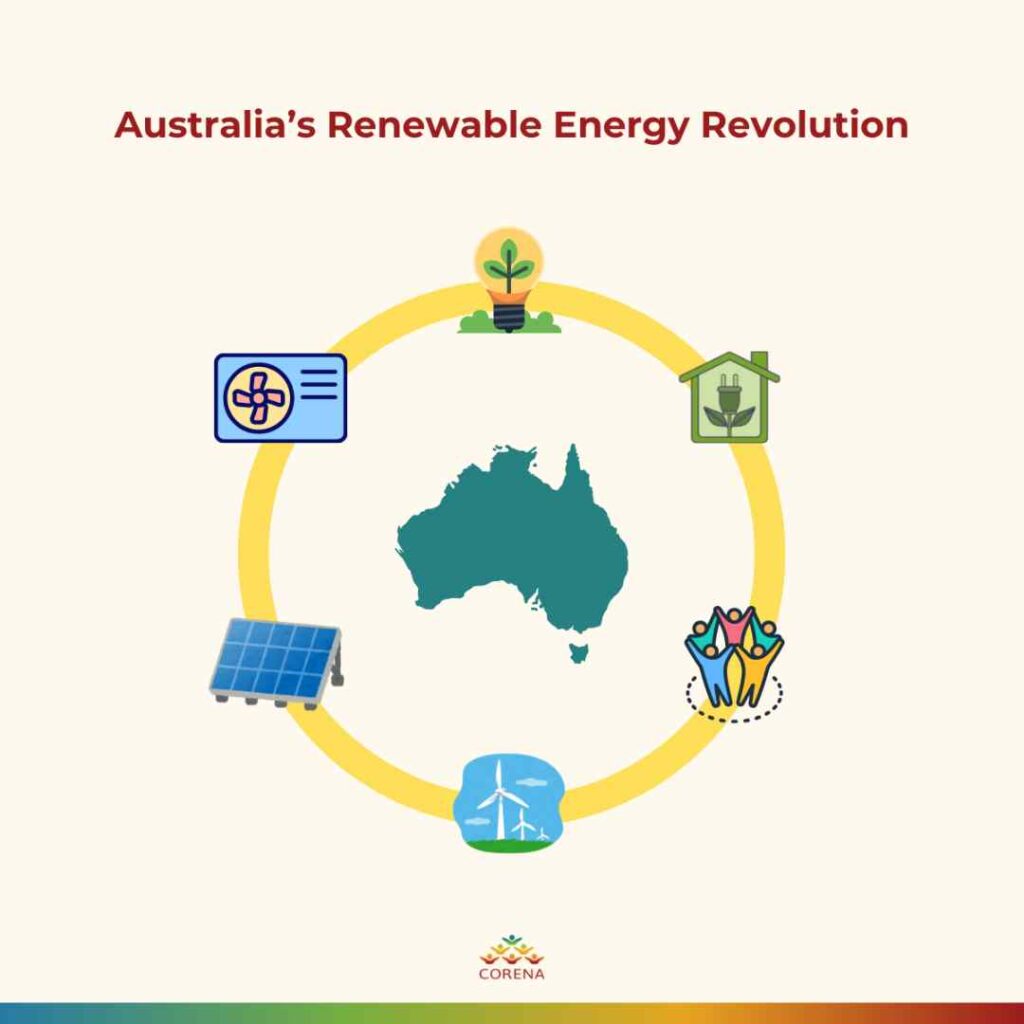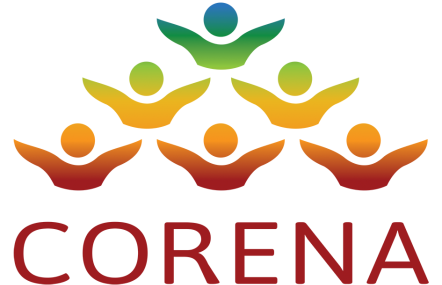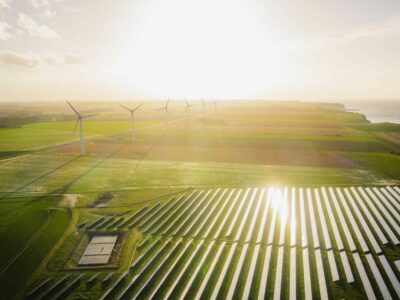Updated: April 2025
There has never been a better time to transition to renewable energy and technologies like electric vehicles in Australia. Over recent years, the country has undergone something of a renewable energy revolution, with solar power capacity growing in leaps and bounds as well as more and more people and organisations alike getting off fossil gas, increasing their energy efficiency and reducing their carbon emissions.
As a result of the increased sense of urgency felt across the world, new and innovative sources of funding for solar panels and other types of renewable energy have become more widely available.
Let’s take a look at how the renewable energy revolution is playing out in Australia and how you can be a part of it.
The Status of the Energy Transition in Australia
Australia’s carbon target is to reduce carbon emissions by 43% by 2030 and achieve net-zero emissions by 2050. According to the Australian Trade and Investment Commission (Austrade), Australia is set to become an energy superpower in renewable energy thanks to the significant amount of renewable resources at its disposal. These renewable power resources include solar, wind, and hydropower.
Australia possesses the thirty third-largest potential for solar power out of all the countries in the world. There is significant potential for the development of large-scale solar energy projects, thanks to the wide open spaces abundant throughout the country and long periods of strong sunshine throughout the year. The country’s open coastlines also provide some of the best wind resources globally.
In 2023 renewable sources made up 35% of Australia’s total electricity generation, up 3 percent on the share in 2022. Most of this renewable energy was generated by wind and solar, with a small portion attributed to bioenergy. Power generated by hydroelectric plants also played a role. 5.9 GW of renewable capacity was added in 2023 with 3.1 GW from rooftop solar..
The Levelised Cost Of Energy cost range for variable renewables in Australia (solar PV and wind) with integration costs (i.e. These are the additional costs of ensuring supply is reliable when using intermittent energy sources including batteries and transmission costs) is the lowest of all new-build technologies in 2024 and when projected for 2030.
This generation didn’t just come from big solar and wind farms. The transition to renewable energy is being fast tracked by rooftop solar on homes and businesses. Rooftop solar is a key contributor to the nation’s energy mix, with a generation share of 12.4% for all of 2024 (up from 11.2% in 2023 and 6.5% in 2020). In some places like South West WA, rooftop solar capacity outstrips the capacity of state-owned generator Synergy’s 854 MW coal-fired Muja Power Station.
Check out real-time data on OpenNEM where you can see different data sets like Renewable Energy Production Vs Fossil Fuels.
By installing solar on the roof of your home or workplace you are having a very real impact on the decarbonisation of the grid.
Learn more in Why Solar Panels Are A Top Renewable Energy Source

Emerging Renewable Energy Trends & Technologies
As renewable energy uptake has taken off, so too have various ways it can be used, supported by advances in technology that can both improve its efficiency and effectiveness, as well as enable more people and communities to directly benefit from it.
Renewable Energy Batteries
Batteries can be installed to store excess energy produced by solar panels and wind turbines for use when the sun isn’t shining or the wind is blowing. In addition to maximising renewable energy use, they can also provide backup power during blackouts and help to improve energy resilience. To ensure a battery meets your needs, your energy use patterns should be assessed to determine the best battery size and assess what the financial returns will be for you.
Learn more in Solar & Renewable Energy Batteries: Why, When & How To Use Them
Community Energy
There is a growing movement towards community energy projects in Australia, empowering local communities to control their energy production and consumption. These projects encompass renewable energy and efficiency initiatives developed, owned, and operated by a local community for their benefit. The types of projects which can make up a community energy scheme include, solar gardens, solar bulk-buying schemes, wind farms, community batteries, shared electric vehicles, and energy efficiency programs. Such initiatives can offer numerous benefits, including reduced energy costs, increased energy independence, local job creation, and environmental advantages through reduced emissions and increased renewable energy use.
Learn more in A Guide to Community Energy in Australia: Power to the People
Solar Facades, Balconies, & Building Materials
Building-integrated photovoltaics (BIPV) involve integrating solar energy sources directly into building materials like solar roof tiles and windows. The benefits of solar facades include reduced energy bills and a smaller carbon footprint, contributing to carbon neutrality. BIPV offers benefits such as reduced energy consumption, lower greenhouse gas emissions, and improved energy security.
Learn more in Solar Facades, Balconies, & Building Materials: Powering the Future
Virtual Power Plants (VPP)
A VPP is a networked system that aggregates distributed energy resources, like solar panels, batteries, and smart devices, into a unified power source. Using sophisticated software, VPPs manage these resources to balance energy supply and demand, enhancing grid stability. They can be categorised into home, business, mixed, and electric vehicle (EV) VPPs, depending on the connected energy sources. This collaborative approach allows for efficient utilisation of renewable energy, reduces reliance on traditional power plants, and provides a more resilient and sustainable energy grid.
Learn more in Virtual Power Plants: Sharing Renewable Energy Resources
Vehicle-To-Grid (V2G) Technology
V2G technology transforms electric vehicles (EVs) into dynamic energy storage systems, or a battery on wheels. This allows bidirectional charging, enabling EVs to store excess renewable energy and supply it back to homes, workplaces, or the grid during peak demand. The benefits of V2G include reduced energy bills, increased grid stability, support for renewable energy integration, and lower emissions. V2G systems use communication protocols for secure interaction between the EV, charging station, and grid. Advanced battery management systems are crucial for monitoring battery health. While this technology has not yet been adopted to a large extent in Australia, and further challenges exist, the recent approval of a new standard for bidirectional chargers in Australia and the release of the National Roadmap for Bidirectional EV Charging supports wider adoption.
Learn more in Vehicle-To-Grid (V2G) Technology: Using EVs as a dynamic energy storage system
Future Potential & Innovations In Renewable Energy
Most of the world’s Hydrogen is extracted from fossil fuels like methane gas, a process which creates significant carbon emissions.
Green Hydrogen involves using renewable electricity to extract hydrogen from water. It requires a significant amount of renewable energy to produce and the process involves a number of stages, with energy losses at each of them, particularly as very specialised equipment is needed to store and deliver the highly explosive gas. On average, only 38% of the source energy remains to drive the wheels of a hydrogen vehicle, compared to around 80% for battery electric vehicles.
In addition, hydrogen fuel and vehicles are expensive and very difficult to source in Australia.
In 2023 only 2 models were available for business leasing and 6 hydrogen vehicles in total were sold. This means it’s unlikely to be competitive as a fuel for transport compared with battery electric vehicles.
However, Green Hydrogen is an energy source that has the potential to help replace fossil fuels in some very energy-intensive sectors like heavy freight transport, steel, fertilisers and green ammonia. Australia has many hydrogen projects currently in the pipeline and with our abundant renewable resources, has the potential to export green hydrogen to other countries.
Learn more in Green Energy Innovations & Emerging Renewable Technologies
Other Resources
Australia also possesses a substantial amount of rare earth minerals and other critical metals needed to facilitate the global energy transition.
Among these minerals are some of the largest known reserves in the world of zinc, nickel. tantalum, cobalt and lithium. These are essential for ensuring a global transition to net-zero emissions.
Australian States Embrace Renewable Energy & Net Zero
Beyond the federal level, Australia’s states and territories are charging ahead with net zero initiatives, by offering a range of programs and grants aimed at encouraging the development of innovative renewable energy projects. Although some jurisdictions such as the ACT and SA are already predominantly powered by renewable sources, others, like Queensland and Victoria, have a lot of catching up to do.
Australian Capital Territory Renewable Energy Initiatives
The ACT Government’s Climate Choices states that since 2020, 100% of electricity in the Capital Territory has come from renewable sources. They also aim to transition away from gas by 2045.
Check out CORENA’s ACT Projects
New South Wales Renewable Energy Initiatives
NSW Climate and Energy Action states that over the past 5 years the share of wind and solar in the NSW electricity generation mix has more than tripled and now makes up 53% of the state’s energy generation capacity! Additionally, Australia New Zealand Infrastructure Pipeline reports that the NSW Government has committed to develop five Renewable Energy Zones (REZ) in the state.
Check out CORENA’s NSW Projects
Queensland Renewable Energy Initiatives
According to Queensland Treasury , as of June 2024, renewable sources are generating 27% of QLD’s electricity, including wind, solar, hydropower and bioenergy and the Government has plans to close all publicly owned coal-fired power stations by 2035.
Check out CORENA’s QLD Projects
South Australia Renewable Energy Initiatives
The Government of South Australia Energy & Mining’s aspiration is for SA to achieve 100% net renewables by 2027. The State met 100% of its operational demand from renewable resources on 180 days (49%) in 2021.
Some key projects to help meet the target include:
“The construction of a world-leading hydrogen power station, including 250 MWe of electrolysers, 200 MW of power generation and associated hydrogen storage facility; a new energy interconnector between South Australia and New South Wales, will support the expansion of the renewable sector by enabling green energy produced in SA to be exported to NSW; a network of potentially 50,000 solar and Tesla Powerwall home battery systems across the State, all working together to form the world’s largest virtual power plant.” Source: https://www.energymining.sa.gov.au/industry/modern-energy/leading-the-green-economy
Check out CORENA’s SA Projects
Tasmania Renewable Energy Initiatives
Tasmania achieved 100% renewable energy in 2020. The Tasmanian Renewable Energy Action Plan’s goal is to increase the State’s renewable energy output to 200 per cent of current needs by 2040.
Check out CORENA’s TAS Projects
Victoria Renewable Energy Initiatives
Victoria has set a target for 95% of all electricity to come from renewable energy by 2035, and boosted its 2035 target from 50% to 65%. To help achieve this, Invest Victoria reports, the Victorian Government has an unprecedented A$1.6 billion energy package designed to create renewable energy hubs across the state, improve crucial grid upgrades, and support other renewable energy projects.
Check out CORENA’s VIC Projects
Western Australia Renewable Energy Initiatives
Western Australia has allocated A2.8bn) in its 2023-24 state budget for energy storage, wind power generation and transmission network upgrades of the state’s main electricity grid.. The Energy Transformation Strategy is the WA Government’s work program to respond to the energy transformation underway and to plan for the future of the State’s power system. Austrade reports that the Western Green Energy Hub, comprising 26 GW of wind and solar capacity, would be one of the world’s biggest renewable energy projects and one of the largest projects ever seen in Australia.
The Clean Energy Future Fund supports investment-ready innovative clean energy projects of high public value.
Check out CORENA’s WA Projects
According to the Clean Energy Council, investments in Australia in large-scale clean energy came to as much as $6.2-billion in 2022, which was a 17% increase over the previous year. It is expected that this will increase again in the years ahead.
International Renewable Energy Initiatives & Cooperation
Beyond Australia’s shores there are also some exciting and cutting-edge international projects that would enable Australia to both export and import renewable energy.
Australia-Asia Power Link (AAPowerLink)
Sun Cable’s AAPowerLink and associated projects, aim to supply solar energy sourced from the Northern Territory to Darwin and Singapore. AAPowerLink involves creating a large renewable energy generation and battery storage facility and a 5,000km high-voltage direct current (HVDC) system.
DarwinLink focuses on establishing a renewable energy industry in Northern Australia, providing industrial customers in Darwin with 24/7 renewable electricity. The final investment decision is expected in 2027, with construction planned to begin in 2028 and an operating life of 70 years.
SingaporeLink includes a 4,300km HVDC subsea cable system from Darwin, through Indonesia, to supply Singapore with 1.75GW of 24/7 renewable electricity, meeting nearly 10% of Singapore’s electricity needs. Sun Cable is collaborating with the Indonesian government to minimise the environmental impact of the subsea cable route. The projects are expected to bring substantial investment and job creation to Australia, Indonesia, and Singapore, while supporting Singapore’s net-zero emissions goal by 2050.
Trans-Tasman Power Link
Taslink, a NZ-based company, is developing a 2600km deep-sea power cable across the Tasman Sea to enable the trade of surplus electricity between Australia and New Zealand. The project aims to take advantage of the two countries’ differing peak demand times due to their time difference and seasonal variations. This would allow Taslink to purchase renewable energy from one country when it’s cheaper and sell it to the other, potentially lowering electricity prices for consumers in both nations. New Zealand generates approximately 85% of its electricity from renewable sources, primarily hydropower, geothermal, and wind power.
The HVDC would be the deepest of its kind in the world, reaching nearly 5km below sea level. The company is currently seeking private funding for the project, with construction potentially beginning in 2028. While Taslink is not seeking government investment, due to the scale of the project, government involvement could be an option in the future.
Join The Revolution
Here at CORENA, we provide an innovative revolving fund model that helps finance non-profit and community organisations who wish to reduce their carbon footprint and improve their energy efficiency, but cannot afford the upfront expense. Our fund ensures that these kinds of climate projects get the funding that they need in order to get off the ground and become part of the exciting and rapidly evolving renewable energy revolution. .
Through offering a zero-interest loan, loan recipients repay the loan through the savings made on operating costs afforded by the low running costs of a renewable energy project over the long term.
Join Australia’s renewable energy revolution and help to finance projects in your community by donating to our revolving fund. We play a role in supporting all kinds of climate projects, from getting off gas to solar power and electric vehicles.
Interest Free Renewable Energy Loans For Non Profits, Community Organisations, Charities, & Social Enterprises
CORENA, can provide free technical advice and zero interest funding to qualifying organisations looking to reduce their emissions and green their energy consumption.To learn more, check out how to apply for a loan, or register for one of our upcoming Online Q&A Information Sessions.

